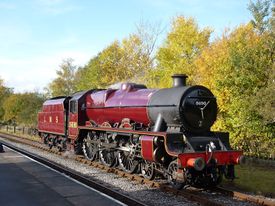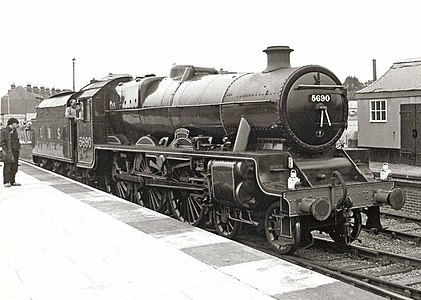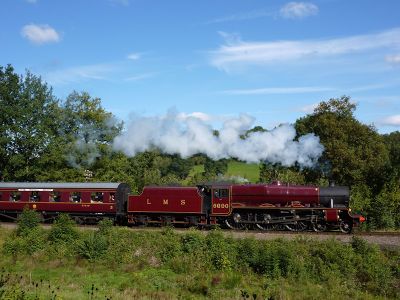LMS Stanier Jubilee 45690 Leander
| LMS Stanier Jubilee 45690 Leander | |
|---|---|
 LMS 5690 Leander in October 2010 | |
| Built By | Crewe |
| Configuration | 4-6-0 |
| Status | Operational, main line registered |
| Loco Number | 45690 |
| Other Numbers | 5690 |
| History | |
| Built | 1936 |
| Designed By | Sir William Stanier, FRS |
| Type | Jubilee |
| 1964 | Withdrawn |
| 1972 | Preserved |
| 1980 | Overhaul at SVR |
| 1983 | Purchased by SVR(H) |
| 1994 | Sold by SVR(H) |
| Technical | |
| Length | 64ft 8¾" |
| Weight | 79t 11cwt |
| Tractive effort | 26,610 lb |
| Pressure | 225 lb/sq in |
LMS Stanier Jubilee 45690 Leander (LMS No 5690) was resident on the SVR between 1980 and 1981 for a contract overhaul and between 1983 and 1994 as an SVR-owned locomotive. She was also a visitor to the 2010 Autumn Steam Gala.
Leander is an LMS 4-6-0 Jubilee class locomotive, designed by Sir William Stanier. The Jubilee class, of which 191 were built, was an update of the LMS Fowler 3-cylinder Patriot or 'Baby Scot' design of 1930 incorporating a Stanier/Swindon design of tapered boiler and modified cylinders. Jubilees were mainly used on 'second division' express passenger services, and were rated as 5XP by BR following nationalisation.[1]
As of 2020[update] Leander is owned by the Beet family, and operated on the main line by West Coast Railways.
Contents
45690 in service
Leander was built in 1936 at the LMS works at Crewe at a cost of £6,469 as Makers Number 288, Lot Number 121.[2] The locomotive was named after HMS Leander (see below) and entered service in March of that year as LMS 5690. She worked out of Crewe North depot until 1947, principally on services to London Euston, Shrewsbury, Holyhead, Liverpool, Blackpool, Glasgow, Carlisle and Perth.[1]
In September 1947 Leander was loaned to Bristol Barrow Road, with the allocation becoming permanent the following month. In May 1948 the locomotive was renumbered 45690 by BR.[3] Leander was one of a small group of Jubilees at Bristol which worked services to Birmingham, Derby, Sheffield, Leeds and York.
By the early 1960s dieselisation of services around Bristol saw the Jubilees reduced to menial tasks, and Leander was withdrawn by BR in March 1964 having recorded 1,589,826 miles in service[1].
45690 in preservation
Leander arrived at Barry Scrapyard in June 1964. In May 1972 the locomotive became just the 18th to leave there,[4] having been purchased by the Stockport engineering firm Oliver, Taylor and Crossley Limited who financed the move to BREL's Derby Works for restoration to mainline condition. In August 1973 Leander, in LMS maroon livery, moved to the Dinting Railway Museum, Glossop where the locomotive was based until 1979. A small support crew was formed who looked after 5690 on main line trips to York, Hereford, Chester and Didcot and also to Rail 150 at Shildon in 1975.[1]
Ownership was taken over by two Leicestershire businessmen who formed The Leander Locomotive Limited in 1977. While based at Carnforth, main line work continued including visits to Newport, Carlisle and Perth, and also to Rocket 150 at Rainhill in 1980[1].
45690 at the SVR
Leander first arrived on the SVR in August 1980 for contract work to be carried out on the boiler to return it to main line standard. Prior to the overhaul starting, the locomotive worked passenger services on both the August Bank Holiday weekend and September Enthusiasts' Weekend.[5] The repair work, which included replacement of a great many stays, copper welding and re-tubing, lasted until late 1981. After completion, Leander was 'renamed' by Commander Drake of HMS Leander at a ceremony on 14 November 1981, following which the locomotive left the Railway.[6]
Leander re-commenced work on the main line, including the 'Cumbrian Mountain Express' on 23 January 1982.[7] The locomotive then made a short return visit to the SVR in spring 1982, working passenger services on 3-4 April.[8]
During this time good working relations were established between the owners/support crew and SVR staff. When the owners put Leander up for sale in November 1983, they approached the SVR and SVR(H) agreed to purchase the locomotive with part of the deal also involving the sale of Ivatt 2MT 46443 in exchange.[1][9] The purchase included sister engine 45699 Galatea, then regarded as a source of spare parts for Leander.
Leander was 'on tour' on the main line at the time of purchase, on 18 February 1984 hauling the Steam Locomotive Operators Association's 'Welsh Marches Express' leg from Hereford via Abergavenny and Maindee North Junction to Newport.[10] The locomotive first returned to the SVR as a 'home engine' on 20 February 1984.[1] Main line work continued with three 'Welsh Marches Expresses' before a return to the SVR for the April Spring Steam Gala.[11]
On Monday 30 July 1984 Leander participated in the opening of the extension to Kidderminster, hauling the inaugural Bridgnorth to Kidderminster service, "The Kidderminster Envoy".[12] Later that year 5690 returned from Didcot to Bridgnorth on 6 October, double-heading the 2.38pm from Kidderminster with GWR 4930 Hagley Hall in the process.[13]
Over the winter of 1984-85 the left-hand side motion was overhauled, the other side having been done earlier in the year. The return crank had a new bush fitted which seized up on test, putting a slight bend into the eccentric rod. Immediate repairs enabled a filming contract to be fulfilled.[13]
In 1985 Leander became the first SVR-based locomotive to work in Scotland, doing a 'Fair Maid' rail tour on 30 March and 6 April (Edinburgh-Perth-Edinburgh).[13] Having returned from the successful Scottish tour, the locomotive was 'embargoed' from further main line outings until excessive side play in the axle boxes could be addressed. This was made difficult by the lifting jacks being unable to lift 5690 when fitted with a boiler as they were limited to 60 ton maximum lift; the SVR having no wheel drop at the time. Later that year the locomotive left Bridgnorth with Tyseley's 7029 Clun Castle to attend a Tyseley Open Day as a reciprocal arrangement for 7029's visit to the SVR. While at Tyseley, their wheel drop was used to remove the axle boxes which were re-metalled and machined at Bridgnorth and refitted at Tyseley.[14]
The repair enabled Leander to return to the main line in 1986, including a Hereford-Shrewsbury-Hereford run on 29 March. 75069 and 5690 then worked a rail tour from Hereford via Gloucester to Swindon on 31 May, remaining at Didcot until returning on via same route on 28 June. This enabled the SVR to exchange the two locomotives with Didcot's 6998 Burton Agnes Hall and 5051 Drysllwyn Castle which worked the opposite legs of the tours, enabling them to visit the SVR between those two dates.[15] During August 1986, 5690 was one of three SVR locomotives used in filming Granada TV's A Wreath of Roses.
During 1987 Leander was wholly based on the SVR, with occasional mutterings from drivers about "steam by-passing the cylinders and blowing through the steam chest straight up the chimney". A report in SVR News in summer 1988 noted that the locomotive had "…made an appearance at the Spring Gala, but has otherwise remained spare so far this year". Later in 1988 5690 was still "trundling up and down", although in need of a piston and valve repair with "…an off-beat sound and occasional bits of ring found stuck in drain taps".[16] Over that winter a complete steam chest and cylinder re-bore was carried out, after which new pistons, rings and piston valves were fitted. While shunting the locomotive back to the shed after taking final dimensions for valve setting, a cotter pin fouled a valve cover resulting in a badly bent radius rod. Fortunately a forging company was able to straighten the damage out.[17]
Leander continued in SVR service until winter 1989, but was then stored awaiting a major overhaul including both boiler and mechanical work, the latter being mainly related to the axle boxes.[18]
The mileage recorded by Leander as an SVR locomotive was as follows:
| Year | Mileage |
|---|---|
| 1984 | 3,547 |
| 1985 | 2,356 |
| 1986 | 2,032 |
| 1987 | 1,344 |
| 1988 | 3,131 |
| 1989 | 3,048 |
| Total | 15,458 |
Sale by SVR(H)
In winter of 1994 the SVR(H) Board announced the sale of 45690 Leander to the family of Dr. Peter Beet (and of 45699 Galatea to another unnamed purchaser). The justification given was that the offer was attractive, the locomotive had been stored out of use for 5 years, funds were not available for a General Repair, and once repaired the locomotive would see limited use on the SVR due to its size and axle loading. Predictably many members complained of the Railway ‘selling the family silver’[19].
Gala visit
Leander returned to the SVR for the Autumn Steam Gala of 2010, which celebrated the 40th anniversary of the SVR’s official opening.
HMS Leander
Since 1870 there have been six ships of the Royal Navy named HMS Leander after the Greek hero Leander. The fifth, which was in use when 5690 was named in 1936, was a Leander-class light cruiser launched in 1931. She was transferred to the New Zealand Navy in 1937, returned in 1945 and scrapped in 1949. The sixth, which was numbered F109 and whose Commander attended the renaming ceremony in 1981, was a Leander-class frigate launched in 1961 and expended as a target in 1989[20].
See also
References
- ↑ 1.0 1.1 1.2 1.3 1.4 1.5 1.6 SVR Stock Book Eighth Edition
- ↑ Jubilees.co.uk
- ↑ BR Database
- ↑ Beckett & Hardingham (2010) pp. 67, 73.
- ↑ SVR News 57
- ↑ SVR News 59, 61, 62
- ↑ SVR News 63
- ↑ Photos in SVR News 64, 70
- ↑ SVR News 70
- ↑ Six Bells Junction
- ↑ SVR News 71
- ↑ SVR News 73
- ↑ 13.0 13.1 13.2 SVR News 75
- ↑ SVR News 77, 78
- ↑ SVR News 79, 80
- ↑ SVR News 88, 89, 90
- ↑ SVR News 91, 92
- ↑ SVR News 101
- ↑ SVR News 113, 114
- ↑ HMS Leander on Wikipedia (retrieved 5 March 2021)
Links
LMS Jubilee Class 5690 Leander on Wikipedia
| ||||||||||||||||||||||||||||||||||

